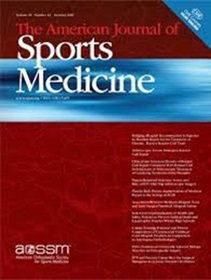低氧条件对负荷受损运动员:在损伤和残疾管理中潜在应用的叙述综述。
IF 9.4
1区 医学
Q1 SPORT SCIENCES
引用次数: 0
摘要
负荷受损运动员是指患有急性或慢性损伤或残疾的个体,这些损伤或残疾阻碍了他们达到最高水平的能力。缺氧调节大致分为全身性(即暴露于陆地或常压缺氧)和局部性(缺血预处理,血流限制训练)两种方法,这可能是增加负荷受损运动员运动耐受性的可行选择。目的:本综述评估了缺氧调节作为负荷受损运动员的训练和康复工具的潜力。它探讨了它在各个康复阶段和关键的残疾人亚群中的应用,包括脊髓损伤、肢体缺陷和脑瘫。证据:在包括固定或最小负荷的早期康复阶段,使用外肢体压迫的被动缺氧调节策略有助于维持肌肉骨骼功能。随着康复的进展,全身和局部缺氧调节(即限制血流量的运动)有效地调节外部负荷,同时保持足够的(内部)生理应变,以较低的机械应力诱导有益的心脏代谢或肌肉骨骼适应。面临生物力学限制、活动肌肉量减少或肌肉无力等挑战的残疾人运动员可以从缺氧调节中获益,以增强肌肉有氧功能,促进肌肉力量和肥厚,并在低机械负荷下改善心肺功能。结论低氧条件反射是一种很有前景的干预措施,可以潜在地克服负荷受损运动员所面临的生理和生理挑战。通过解决他们的特定局限性,低氧条件可以优化康复和训练结果。未来的研究是必要的,以完善低氧条件协议,并量身定制,以最大限度地提高个人适应能力和表现在不同负荷受损的运动员群体。本文章由计算机程序翻译,如有差异,请以英文原文为准。
Hypoxia Conditioning for Load-Compromised Athletes: A Narrative Review Exploring Potential Applications in Injury and Disability Management.
BACKGROUND
Load-compromised athletes are individuals with acute or chronic injuries or disabilities that hinder their ability to perform at peak levels. Hypoxia conditioning is broadly categorized into systemic (i.e., exposure to terrestrial or normobaric hypoxia) or localized (ischemic preconditioning, blood flow restriction training) approaches and could represent a viable option to increase exercise tolerance of load-compromised athletes.
PURPOSE
This review evaluates the potential of hypoxia conditioning as a training and rehabilitation tool for load-compromised athletes. It explores its applications across various rehabilitation stages and key para-athlete sub-groups including spinal cord injury, limb deficiency, and cerebral palsy.
EVIDENCE
Passive hypoxia conditioning strategies using external limb compression help maintain musculoskeletal function during early rehabilitation stages involving immobilization or minimal loading. As rehabilitation progresses, both systemic and localized hypoxia conditioning (i.e., blood flow restricted exercise) effectively modulates external load while maintaining adequate (internal) physiological strain to induce beneficial cardiometabolic or musculoskeletal adaptations with lower mechanical stress. Para-athletes facing challenges such as biomechanical limitations, reduced active muscle mass, or muscle weakness can benefit from hypoxia conditioning's capacity to enhance muscle aerobic function, promote muscle strength and hypertrophy, and improve cardiorespiratory performance at lower mechanical loads.
CONCLUSION
Hypoxia conditioning emerges as a promising intervention to potentially overcome the physical and physiological challenges faced by load-compromised athletes. By addressing their specific limitations, hypoxia conditioning can optimize rehabilitation and training outcomes. Future research is essential to refine hypoxia conditioning protocols and tailor them to maximize individual adaptability and performance across diverse load-compromised athlete populations.
求助全文
通过发布文献求助,成功后即可免费获取论文全文。
去求助
来源期刊

Sports Medicine
医学-运动科学
CiteScore
18.40
自引率
5.10%
发文量
165
审稿时长
6-12 weeks
期刊介绍:
Sports Medicine focuses on providing definitive and comprehensive review articles that interpret and evaluate current literature, aiming to offer insights into research findings in the sports medicine and exercise field. The journal covers major topics such as sports medicine and sports science, medical syndromes associated with sport and exercise, clinical medicine's role in injury prevention and treatment, exercise for rehabilitation and health, and the application of physiological and biomechanical principles to specific sports.
Types of Articles:
Review Articles: Definitive and comprehensive reviews that interpret and evaluate current literature to provide rationale for and application of research findings.
Leading/Current Opinion Articles: Overviews of contentious or emerging issues in the field.
Original Research Articles: High-quality research articles.
Enhanced Features: Additional features like slide sets, videos, and animations aimed at increasing the visibility, readership, and educational value of the journal's content.
Plain Language Summaries: Summaries accompanying articles to assist readers in understanding important medical advances.
Peer Review Process:
All manuscripts undergo peer review by international experts to ensure quality and rigor. The journal also welcomes Letters to the Editor, which will be considered for publication.
 求助内容:
求助内容: 应助结果提醒方式:
应助结果提醒方式:


